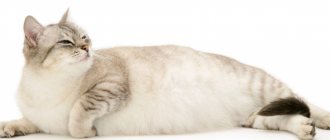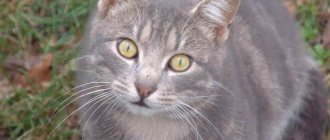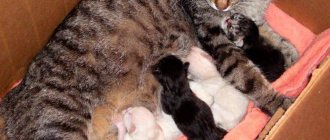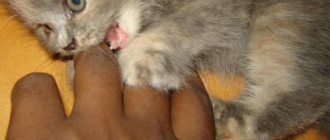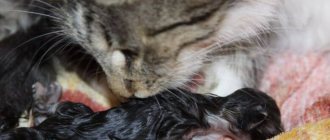How to help a cat during and after birth?
The decision has been made, now we need to wait for the right moment.
In young females, sexual desire is often weak. But each time the desire to become a mother will become stronger, and the pet will demonstrate it more and more often. Under optimal conditions, a cat can give birth twice a year, but she can only be bred if she is in good physical shape. Young animals often behave timidly with partners or even refuse to mate. In this case, it would be best to choose an experienced partner, then the process will most likely be completed successfully. Moreover, pets need to be introduced in advance, leaving them together for 15 minutes or more.
Sometimes owners rush to the veterinarian to show their pet. And here the specialist’s task is to tell how the cat behaves after mating. For several days she will look tired and spend time in her house. This does not mean that she is sick. It’s just that mating is an extremely energy-intensive process. The pet now needs to sleep and regain its strength.
But you can’t completely let down your guard either. If the animal is just sleeping, then leave it alone. It is worse if this is accompanied by high fever, vomiting or diarrhea. This already suggests that the mating took place against the background of a progressive disease. Normally, you may notice changes within a few days. The cat develops a wonderful appetite. However, just by how a cat behaves after mating, it is impossible to say for sure whether she is pregnant.
Surprisingly
somewhat similar to the behavior of a pregnant woman. And the owner should treat the future mother cat with special care and attention. More often
- In the first weeks of pregnancy, the cat's appetite decreases and sometimes vomits;
- The animal becomes less active than before and tends to rest more;
- After about 3 weeks, the animal's nipples become more intensely pink and enlarge;
- After 4 weeks, the animal’s appetite noticeably improves, the cat asks for food very often, and its weight becomes greater;
- Sometimes a pregnant cat may refuse her favorite food, giving preference to new foods and even products that are unusual for her;
- After 5 weeks, the cat’s belly becomes visible to the naked eye;
- Week 7 is characterized by fetal movement in the stomach;
- Shortly before giving birth, a cat may show aversion to other animals (especially of the opposite sex), but there are exceptions when the cat is friendly with everyone;
- The closer the lambing, the more attention the cat demands from the owner, sometimes chasing him;
- A few days before giving birth, the animal may look for secluded places for future offspring (in the closet, under the bed). The owner will have to find a place for the birth where the cat will feel completely safe;
- The animal becomes especially anxious a few days before giving birth. And on the day of birth, the cat most often purrs continuously, requires the owner to be constantly near her, breathes frequently, tries to lick herself, the cat’s mucous plug comes out of the uterus, the vulva increases in size, and colostrum appears.
Since much depends on the character of the cat and on its well-being at this difficult moment, the animal can behave friendly, but sometimes, on the contrary, overly irritable. It is preferable for the owner to know exactly when the pet was in heat and when the mating occurred. When pregnancy becomes apparent, you should not self-examine your cat's abdomen for kitten counts. This can cause irreparable harm to the offspring.
More often
can last from 6 hours or more, you should try to stay close to the animal during this time, since the presence of the owner nearby will calm the cat. You can often hear advice about cutting the umbilical cord of kittens and wiping them with napkins, but a cat can handle this on her own, even one that is giving birth for the first time.
The place for childbirth must be taken care of in advance. The box and bedding chosen for the cat should be quite large so that the animal can easily change its position, lie down, and turn around. Often, after giving birth, a cat strives to hide her offspring in hard-to-reach places, so the owner should try in advance to limit the animal’s access to linen, the contents of cabinets, shelves, beds and the space under them.
In order for a cat to feel safe, she and her kittens should have a comfortable place in a quiet and peaceful corner of the house. At the same time, the owner should monitor the cleanliness of the litter (especially in the first days after birth), the presence of a bowl of clean water nearby, and the bowl of food should be placed closer to the animal; in the first days after birth, the cat is reluctant to leave the kittens even to eat.
It can be especially difficult for an inexperienced owner whose cat is pregnant for the first time, especially if the animal has free access to the street. From 5-6 months you should be on the alert, because it is at this early age that the cat may go into heat. But it is too early to let such a young animal near a cat, otherwise there may be a lot of problems: protracted labor, the inability to independently reproduce kittens, the appearance of weak and non-viable offspring.
We invite you to read: Instructions for use of Helavit C for cats
In other words, the owner of a female cat over 5 months old needs to monitor the behavior of the pet and exclude her from meeting individuals of the opposite sex. But after a year and a half, you should not resist nature, since the cat’s body is ready for successful mating, fertilization, pregnancy and childbirth.
How to determine if a cat is pregnant?
Nine and a half weeks... Did you think this was an article about a famous movie? Mistake. Nine and a half weeks is the approximate length of pregnancy for a cat.
The deadline, of course, is not strict; there are deviations, both positive and negative (up to 7 days). However, kittens born a week earlier rarely survive.
Although it is believed that Siamese and Abyssinian cats may have a longer gestation period, scientific studies have not confirmed any significant difference in gestation periods between breeds.
Typically, cats with large litters have a shorter gestation period, and cats exposed to stress during the last period of gestation may give birth to kittens slightly later than normal.
However, if the exact time of mating is not known, it is difficult to predict with certainty when the offspring will appear.
- In the first three weeks of pregnancy, the cat becomes less active, eats less, and may even start vomiting. Typically, the first sign of pregnancy is that three weeks after successful mating, the nipples become a distinct pink color, which is especially noticeable when the cat is pregnant for the first time.
- After four to five weeks, the developing embryos become large enough to be felt by gently pressing on the abdomen. However, great care must be taken here and not to press too hard or harshly, this can lead to premature miscarriage. Usually it is impossible to accurately feel the number of embryos.
- During pregnancy, fertilized eggs (zygotes) pass through the fallopian tubes into the uterus. A woman's uterus is pear-shaped and consists of a main body and two very small appendages (left and right), each connected to a corresponding fallopian tube. This is why people usually have one child.
- However, in a cat, the body of the uterus is very short, and each of the processes is relatively long, since the life of several kittens usually begins here. Fertilized eggs are distributed evenly in the processes and are attached to the wall of the uterus.
- Later, a placenta is formed that protects them - it allows oxygen and nitrogenous compounds to flow from the mother’s blood into the kittens’ bodies, and decay products are removed through other channels. However, the mother's blood does not mix with the blood of the embryos; Like other tissues, the blood of embryos is formed during their development.
- Around the sixth week of pregnancy, if more than one or two kittens are formed, the cat's belly suddenly becomes very large at once, clearly larger than before: at this stage the growth of the embryos occurs quickly and they cannot be felt separately. After the seventh week, you can already feel the kittens moving and feel their heads. By this time, the cat becomes restless, looking for a place in which to build a nest.
In the last week, the mammary glands become enlarged and the nipples protrude. The cat becomes inactive, and sometimes a slight white discharge appears at the exit of the vulva.
Some pregnant cats show signs of heat during the third and sixth weeks of pregnancy, meaning they come into heat every three weeks. This is due to the fact that not enough progesterone is produced (this hormone is produced by the ovary during pregnancy, stopping the development of other follicles from which eggs emerge).
If the cat is allowed, it will again have sexual intercourse and become fertilized, and these new eggs may also be fertilized.
The result will be that at the same time there will be embryos of different ages in the cat’s uterus (the phenomenon of superfetation).
If this happens, all kittens may be born at the same time, with the second litter being premature (usually rarely surviving), but in rare cases they are born separately, with the second litter being born later.
Pairing
During estrus, the female makes special sounds, purrs and crouches to the floor. When she is located towards her partner, she takes a special pose, arches her back and moves her tail. The male holds her by the withers with his teeth and covers her. Sexual intercourse lasts several seconds. If this is your first mating, then it will be important to find out in advance how the cat behaves after mating.
She pushes the cat away, makes characteristic high-pitched screams, begins to lick herself furiously and demonstrates her reluctance to continue communication. In some cases, she may show aggression and attack. In others it is simply secluded. Sometimes owners wonder why the cat tumbles after mating.
There is no need to be afraid of such behavior. The cat behaves this way after mating not because she is in pain. It’s just that nature very wisely doses the sexual desire of females. In this case, it has fulfilled its function, and repeated sexual intercourse will become possible only after some time. Usually, in order for pregnancy to occur with a 99% probability, cats are bred three times, on the second or third day of ovulation. Another option is to allow animals to mate during the three most favorable days of estrus.
When will they find out?
To accurately determine if an animal is pregnant, you can consult a doctor. A specialist will tell you with 100% confidence whether you should expect kittens soon. Typically, veterinarians use the following methods to recognize pregnancy in cats:
- Palpation. An experienced doctor will determine whether a cat is pregnant already on the 15th day after sexual intercourse, simply by feeling her uterus through the abdomen. A little later, on day 30-40, the veterinarian will even be able to tell the owner the exact number of fetal kittens;
- Ultrasound of the uterus. The study is carried out no earlier than 15 days after mating with the cat, already at this short period the pregnancy will be visible. And on days 24-25 after fertilization, you can see the kittens’ hearts beating;
- X-ray. In this way, it is possible to determine whether a cat is pregnant no earlier than 40-45 days after mating, when the skeletal system of the kittens is formed;
- Donating blood for relaxin, a hormone produced by the placenta from the 20th day after fertilization. This is a kind of cat pregnancy test, which allows you to either confirm that the female will soon become a mother, or refute such an assumption. It is believed that an analysis of this kind should be carried out no earlier than 26-30 days after mating, otherwise the result may turn out to be false.
By the way, sometimes worried owners who have once heard about a pregnancy test for cats go to a regular pharmacy for a “human” rapid test. But the test for women shows an increase in a special hormone during pregnancy - human chorionic gonadotropin, which is not synthesized by the animal body, therefore, the result of the test performed on a cat will be incorrect.
How quickly do animals pick up these odors and do cats sense their owner’s pregnancy in the early stages? Every woman's body is different. The hormonal process and the production of external secretions may occur sooner and be more active for some than for others. You can read the stories of women whose cats, through their behavior, reported the owner’s pregnancy before she found out about it by doing a test.
Signs of pregnancy in the first days
In the first days after fertilization, it is almost impossible to suspect pregnancy in a pet. Only some subtle signs will indicate its condition, but they do not give a 100% guarantee:
- increased drowsiness - a particularly noticeable sign in active cats, as playfulness gives way to calmness, in this case the owner may suspect the appearance of a somatic disease. This condition is formed due to changes in the hormonal background of the animal;
- cessation of estrus earlier than usual is an indirect sign of conception. On average, the period lasts about three days, so a reduction in the duration of the phase may indicate fertilization;
- a few days after mating, there may be a decrease in appetite due to the occurrence of nausea in the animal, while normally a pregnant cat does not experience frequent vomiting and complete refusal of food, such symptoms may indicate the presence of a disease;
- changes in nipple pigmentation occur under the influence of hormones, while the skin intensifies its color; this sign is in many cases difficult to detect from the first days of pregnancy.
Shows of affection
Do cats sense their owner's pregnancy in addition to smell? Most often, women note that their pets strive to lie down on their stomachs, purring loudly, even if such behavior was previously unusual for the pet. Animals show such interest in the belly of pregnant women not only in relation to their owners.
A cat can behave in a similar way towards a guest who is in a position. The desire to lie down on their stomach or nearby, so as to come into contact with it, is characteristic not only of cats, but also of cats. Sometimes a wayward and not very affectionate animal begins to show special tenderness to the abdominal area of its owner.
But what exactly is it about these areas that attracts animals so much? If the interest in the breasts can be easily explained by the fact that its enlargement and swelling causes even a slight increase in temperature, to which cats are very sensitive. In addition, the transformations that occur in the mammary glands in order to adapt them to milk production also contribute to the appearance of special odors, elusive to others, but attractive to animals.
But how to explain the cat's interest in the belly of pregnant women? Perhaps they feel changes in pressure, temperature, muscle tone, some subtle vibrations, or energy that no equipment has yet captured? One can only guess about this. There are many speculations as to whether cats can feel their mistress’s pregnancy on an energetic level. Sometimes these animals are endowed with psychic qualities, but there is no direct evidence of this.
We suggest you read: Is it possible to give a cat activated carbon dosage?
Causes for concern
Let's dwell on this point a little more, since the issue is related to the life and health of your pet. If, after mating, the animal behaves as if it were sick, including vomiting, diarrhea, and fever, there are several reasons for this:
- Reaction to stress. Presence of a male, moving.
- Digestive disorders due to dietary habits, if the animal was given to another home for mating.
- The possibility of toxic infection cannot be ruled out. It has nothing to do with knitting.
- Before mating, check whether the male is vaccinated against the most dangerous diseases. There are a number of bacterial or viral infections that can be sexually transmitted.
If a cat does not eat for more than two days after mating, then the reason is more serious than it seemed at first glance. It is especially important to see a veterinarian as soon as possible if your cat refuses water.
Rules for keeping expectant mothers
Requirements are similar to those of males. The owner is obliged:
- provide the animal with adequate nutrition;
- introduce vitamins and microelements, calcium and folic acid are especially important;
- maintain a normal weight for your pet (obese or malnourished animals are unlikely to become pregnant);
- do not overload the body with frequent pregnancies: twice a year is enough;
- monitor exercise: active physical activity will make the cat stronger, and pregnancy and childbirth itself will be easier;
- do not forget about education: only a well-bred mother can instill in kittens the basics of good behavior.
In addition, even before mating, the cat should be assessed by experts who will highlight its advantages, identify disadvantages, check the compatibility of two lines and, based on this data, help find a good sire. If you ignore the rule and do not receive a “ticket to breed,” then the kittens born are unlikely to be recognized as purebred.
In principle, that's all. If you have questions, ask in the comments. Read about what to do after mating and what problems there may be afterwards in the next issue.
Thank you for subscribing, check your inbox: you should receive an email asking you to confirm your subscription
- How long does it take for cats to mate?
- How to understand that a cat is asking for a cat
- What to do when your cat is in heat
Overprotectiveness
Some owners say that as soon as they became pregnant, their cats do not leave them without their attention for a minute, constantly accompanying them around the apartment. And if the owner needs to go to the restroom or bathroom, then the pet remains at the closed door and meows continuously. What is it, caring for the owner and her offspring, or are cats so attracted to smells or other sensations that the animals are ready to follow them everywhere? And in this case, there will be no explanation, because it’s always like this with cats: there are more questions than answers.
Features of behavior
There are no exact boundaries here. On the one hand, the behavior of an animal depends on its individual characteristics. Some will meow restlessly, others will sleep serenely. But sometimes a cat’s behavior after mating is simply surprising. She keeps asking for the cat and is acting very restless. It depends on what day of estrus the mating occurred.
During the entire birth, the cat must remain in the nest. If the pet is worried and tries to leave, it must be picked up and calmed down. While struggling, the cat may feel the urge to defecate and go to the litter box. You shouldn’t interfere, but watch carefully what happens next.
With this development of events, especially during the first birth, immediately after defecation, a bladder containing the first kitten emerges from the cat’s birth canal. If this happens, there is no need to panic, just pick up the cat and carefully carry it to the nest. The anus and fur under the tail can be gently cleaned using wet wipes.
Postpartum eclampsia is a common, insidious and very dangerous complication for which you need to prepare in advance. In rare cases, a cat experiencing eclampsia may kill or even eat its own kittens. Such a sight is difficult to endure even for an experienced animal owner, but you will have to pull yourself together to save the life of your pet.
All kittens that are born after this must be picked up immediately, mucus removed from the respiratory tract independently and placed in a separate nest with a heating pad. To save the cat, she needs to start taking calcium supplements and carry out maintenance therapy!
In very rare cases, a cat may kill her kittens if they are not viable. For example, with premature birth, premature kittens most often do not survive. However, for a healthy cat that does not suffer from a disorder of the central nervous system, it is more common to refuse to feed the offspring and completely ignore the kittens.
Mating Scottish cats
The first heat in Scottish cats occurs before 9 months, but early matings are unacceptable, the mother herself may die or kittens with large defects will appear. The young cat’s body is not yet strong and is not ready for lambing. It is recommended to carry out the first mating of Scottish cats after she is 1.5 years old. When mating a Scottish Straight for the first time, certain rules should be followed:
- Breeders and veterinarians recommend allowing the first mating after she is 1.5 years old, when cats bear kittens.
- The applicant's cat is carefully selected; it must be strong, healthy, have the desired coat color and be quite active.
- Scottish folds (low-eared) are mated only with Scottish straights (straight-eared).
At what age should you breed?
The partner, who has reached 1.5 years of age during estrus, is brought together with a pre-selected male for the first mating. Scottish Straight cats can mate from the age of 10 months; from the moment of puberty there are no age restrictions for them. Cats become active in the spring; they behave restlessly, sometimes aggressively. They mark the area around with an unpleasant odor and invite their partner for mating. Scottish cats can mate with a cat and produce offspring on average until they are 7-8 years old and older.
To successfully complete mating and get kittens, you need to be well prepared:
- Both pets must be vaccinated, dewormed and healthy, which is noted in the animal passport
- Mating is always carried out on the cat's territory. Favorable conditions are created for the cat in another house. They maintain her usual diet and provide her with her own tray, with her own scent.
- To ensure the safety of mating, the animals' nails are cut the day before so that they do not scratch each other.
- Partners are given time to get used to each other and get to know each other.
- It is useless to force animals to mate; maybe one of them is not ready for mating for some reason.
Choosing a partner
For cats of the Scottish breed, especially for folds, choosing a partner is not an easy task, but it is an important task for obtaining future offspring. The breeder from the nursery where she was raised can help. You can learn information about breeding cats from local advertising and club publications, look at exhibition catalogues, and you can look at the GCCF stud books, where you can choose a breeding animal.
Scottish studs differ in mating conditions:
- Free cats who can mate with any partner.
- Limited breeding cats, specially kept for a limited circle of club animals.
- Cats are available only for mating with their own type of cat breed within the cattery.
Breeders specifically select and raise breeding cats, keep them in excellent physical shape, and monitor their health and the health of their partner. Do not allow excessive overload of the animal, regulate the number of matings. The period of breeding of cats lasts, as a rule, for 4–5 years, then they are castrated and kept as pets.
Before mating, it is advisable that the breeding cat and the mating partner have a certificate of veterinary examination of the animals.
For the first mating of a young cat, a mature, experienced sire is chosen. Such cats are more expensive, but more reliable, so that mating does not fail due to the animals themselves being unprepared for mating.
If the partners are incompatible, when the cat shows aggression when covering, bites, scratches, then the mating is refused.
For mating, the partner is brought to the cat’s territory, where his owner is responsible for her maintenance during the mating period.
How does mating work?
Mating of animals is a long process and takes place in several periods:
- Preparatory. When a partner is ready for mating, she is taken to the partner’s cat, by prior arrangement. The basket is placed in the place indicated by the breeder so that the cat can look around, get used to the smells, and sniff with the cat.
- The courtship period, which lasts from 3 to 4 days, depends on the temperament of the animals. If this is the female’s first mating, she behaves nervously; she is calmed down by stroking and caressing. If the animal shows aggression, cover it with a blanket until it calms down.
- The mating process takes place under the supervision of the breeder. Before this, the animals are not left alone unattended and, if necessary, are taken to different rooms.
To prevent the animals from slipping, a rug will be placed under their feet. The female gets into a comfortable position, moves her tail, and the panther jumps on her and grabs her by the scruff of the neck. The coating process takes a few minutes.
At the moment the mating is completed, the female screams, rolls around on the floor, and the cat is protected from the aggression of the partner. How to understand whether one mating is enough for mating, therefore, for reliability, the breeder can allow 1-2 more matings of animals. After the process is over, the partners clean themselves up and lick their genitals.
After finishing the covering, the animals are examined, and if there is a wound, they are treated with an antiseptic solution. The fertilization process can last up to 2 days.
Caring for a pregnant cat
Stories about how cats react to their owner's pregnancy are not so sweet. Thus, there are stories about the unambiguous jealousy of animals towards the future offspring of their owners. The pet strives to scratch or bite its stomach, while it may grumble and wag its tail. His actions do not resemble play; the animal is clearly unhappy or irritated.
Pets rarely behave this way, but such cases do occur. The cat is afraid of something. Perhaps he was once picked up on the street, and he is afraid of losing his place in the house, food and the attention of his owners. Or the animal does not like strangers in the house, always has difficulty withstanding guests, and therefore shows hostility towards the upcoming addition to the family.
It also happens that shortly before the owner gives birth, the cat leaves the house and does not return. And this happens quite often, but where the animal can freely leave the home - in a private house or in a country house. Before this, the pet may not have shown any concern, nothing unusual happened in the family, and the owners paid no less attention to it than usual. And it remains a mystery why cats do this.
Does mastitis occur in pregnant cats?
Unfortunately, diseases such as mastitis occur not only in lactating cats, but also in pregnant cats.
- the area around the breast appears swollen and inflamed;
- cracks appear on the nipple, and the nipple itself becomes hard and hot to the touch;
- the pet avoids any touching the inflamed nipple and often licks it;
- a substance similar to cottage cheese or yogurt is released from the nipple.
Mastitis is dangerous because over time it can develop into a malignant tumor. At the first symptoms, the owner should show the cat to a doctor and under no circumstances try to cure the pet on their own.
Sore nipples in the last week of pregnancy
Sore nipples in a cat before giving birth
Sometimes the nipples of a pregnant cat can become inflamed in the last weeks of pregnancy in case of premature lactation (when the kittens have not yet been born, and the cat already has an excess of milk). To prevent the occurrence of mastitis, the pet owner can give her a light massage of the area around the nipples and gently express milk, trying not to cause pain to the pet.
Start of heat
The pregnancy symptoms listed above are observed at 1-3 weeks of pregnancy. And already from 4 weeks, the owner can observe the following changes occurring in the animal:
- Increased appetite and weight gain. As a rule, in the middle of pregnancy a cat does not suffer from nausea; on the contrary, the pet wants to eat more than usual, as a result of which it gains weight;
- The belly begins to grow, which is not associated with overeating. At this stage, it is important not to harm the animal by trying to determine the presence of kittens in the cat’s womb by palpation;
- The cat becomes active again, loves to walk in the air, sometimes play, but usually does not allow cats near her;
- Increased swelling of the nipples. If a change in the shade of the nipples and their slight swelling are signs of pregnancy in cats in the early stages, then at 4-6 weeks the animal’s mammary glands increase in size especially noticeably;
- A pregnant cat's behavior changes. A previously calm and peaceful animal can show aggression towards other pets, even the owner often irritates it. But a normally angry cat can turn into an obedient and quiet animal. There is no need to be afraid, since this is due to hormonal changes.
We suggest you read: How to give Amoxiclav to cats. How to give Amoxiclav to cats
Quite rarely mating occurs during this period. Estrus lasts on average 7-14 days. If productive mating occurs already in the first days, the cat will behave as if it had not happened. In this case, the estrus will continue until the end of the prescribed period.
What will the owner observe? The cat behaves as if pregnancy is not imminent. She constantly demands a cat. But in this case you need to be very careful. If the period of the first 4 days of estrus was chosen for mating, contact can be allowed for three days. After this, a partner cannot be allowed near the cat, since the cat can conceive offspring from different cats, and fetuses can develop in the same uterus for different periods (a week or more). This often leads to the birth of stillborn kittens, as well as exhaustion of the pet.
Here again we are faced with the question of the average duration of estrus. It can be taken as 10 days, then the middle falls on days 5-7. If mating occurs at this time, the animal calms down almost immediately. After mating, the cat sleeps, becomes very affectionate, and eats well.
What happens if your pet's cycle is longer? As in the first case, she may continue to show anxiety. But such an active search for the cat is no longer observed.
If professionals plan mating, they usually choose the middle or end of the cycle. In the last 3-4 days, there is a gradual stabilization of hormonal levels. The only risk is that if you calculate incorrectly, then there may be no additional time for re-matings. The heat will end, and you will have to wait for the next opportunity.
How should a cat behave after mating during this period? She usually calms down almost immediately. But you need to make allowances for the individual characteristics of the animal.
Signs of cat pregnancy
Darkened nipples, increased appetite, weight gain, rounded belly - this is what a pregnant cat looks like. Some pets vomit. Changes occur not only at the physiological, but also at the psychological level. The animal becomes affectionate, sleeps a lot, and begins to “nest” closer to birth.
Darkened nipples
By the end of the third week of pregnancy, the animal's mammary glands increase in size, acquire a darker color, and may begin to peel off. The fur around becomes thinner. The changes are clearly visible if the animal is smooth-haired and light in color. If the coat is dark and thick, this symptom may not be noticed.
Morning sickness
Increased appetite
Kittens grow quickly in the belly. To develop, they need nutrients that they receive from their mother. As a result, the animal is constantly hungry and asks for food all the time. These symptoms of a cat's pregnancy may not be noticed if she already had a good appetite.
Weight gain
By the end of pregnancy, your pet can gain 1-2 kg. This is the weight of not only kittens, but also the uterus, placenta, amniotic fluid, fat deposits, and enlarged mammary glands. Weight gain occurs slowly. In the first month, changes will become noticeable if the owner weighs the pet weekly.
Round belly
In the fifth week of pregnancy, the abdomen increases noticeably. By gently stroking the tummy, you can feel the babies moving. Before childbirth, the stomach drops and moves to the hips.
Increased affection and affection
Before the birth of kittens, the animal becomes gentle and requires affection and attentive attention. The cat follows its owner, asks to be held, and often purrs. It happens the other way around - a previously friendly pet becomes withdrawn and irritable. The usual calm purring is replaced by a dissatisfied hiss.
The cat begins to “nest” and sleeps more
Before giving birth, the animal sleeps a lot. When awake, he looks for a quiet, safe place to give birth. To do this, you should prepare a basket or box, first covering it with rags or a soft blanket.
Indifference
The more common reaction of cats to the pregnancy of their owners is behavior without any changes. As a rule, they write about the extraordinary actions of animals and much less often talk about their ordinary habits. However, many cat owners note that their cats show no interest at all in the pregnancy of their owners.
However, can cat owners who show no behavioral changes feel pregnancy? At a minimum, they catch the smell, but perhaps the animal does not correlate it and other changes in its owners with pregnancy, or this phenomenon does not interest them.
The first time a cat is in heat: is it possible to breed?
For cat owners, the problem of mating becomes relevant already at 6-7 months of a pet’s life. At this time, animals usually begin their first heat. The timing of the onset of the first heat depends on several reasons: breed, living conditions, diet, climate, health. In some breeds of animals, heat begins earlier, in others - later. The first heat is often unnoticeable to the owner and occurs without pronounced symptoms.
The onset of the first heat is not a reason for mating. At this age, the animal has not yet formed physically. Early pregnancy not only leads to infertility and the birth of non-viable offspring, but can also cause significant harm to the health of the young body.
When will the pet be ready to bear and give birth to healthy kittens?
Neutered cat and owner's pregnancy
Will the behavior of the animal in this situation depend on its age or whether it is castrated or not? There are no statistical data, but, thinking logically, one can expect that very young or neutered, never mated pets will be indifferent to the pregnancy of their owners. However, there is an example of an incredibly demanding adult sterilized cat who did not want to leave the place near his owner’s belly starting from the fifth month of her pregnancy.
Having studied thematic forums in more detail, you can probably find many more such examples. Therefore, it is hardly possible to deduce any pattern in cat behavior during the pregnancy of their owners. Only the animals themselves know the answer to this question, but they do not reveal their secrets to anyone. After all, there is no more mysterious creature in the world than a cat.
How to distinguish a false pregnancy from a real one
In some cases, indoor and outdoor cats suffer from false pregnancy. The causes of the pathology can be:
- sudden stress or emotional overstrain in the pet;
- mating with a sick cat;
- improper functioning of hormonal levels;
- being near a pregnant cat.
How to understand that a dog is dying: signs of impending death
Only a veterinarian can check for a false form of pregnancy. Using an ultrasound, the cat's uterus is examined. The absence of kittens in the womb indicates the development of pathologies in the pet’s body. Treatment is prescribed depending on the cause and form of the disease. Therapy is often carried out using hormonal agents.
Important! It is necessary to understand that false pregnancy poses a serious threat to the cat’s life. Therefore, ignoring the problem can lead to serious consequences.
An animal's pregnancy may be false.
How to understand that a cat is pregnant
You won’t be able to find out about this until the 21st day, when the first signs become noticeable. If the male is experienced and qualified as a stud cat, there is nothing to worry about, even if the cat continues to worry for a few more days. To guarantee, experienced owners take photos and videos that confirm the fact of mating. In this case, you can be 90% sure of a successful outcome.
There are several methods that help you understand that a cat is pregnant. The first is observation. Swelling of the nipples, growth of the abdomen and good appetite - all this indirectly indicates conception. But the most reliable way is an ultrasound, which is performed on days 21-23 of the expected pregnancy.
It also happens that after sterile intercourse, cats behave as if the development of the embryos is proceeding as usual. They are slow, sleepy and very affectionate. At the same time, the nipples swell, the belly grows, and after the end of the period necessary for bearing offspring, milk begins to be released. But the pregnancy is false. This condition causes mental stress, severe hormonal imbalance and poor health.
Diagnosis of pregnancy in a cat
If your pet is a purebred cat that has spent its entire life in an apartment or house, isolated from street “Romeos,” it will not be difficult to control the process of reproduction of its offspring.
You should visit a veterinarian at the earliest 2 weeks after mating. Already at this stage, it is possible to recognize the first signs of pregnancy in a cat by collecting an anamnesis and palpating the abdomen and mammary glands of the animal.
The most effective diagnostic method: ultrasound. When conducting such a study, embryos can be seen in the 2nd week. And at the 3-4th week, obvious signs of pregnancy in cats are already visible. At this stage, the specialist will be able to tell you about the number of kittens, whether they have a heartbeat (the main sign of vitality), as well as the general condition of the cat's uterus. To independently diagnose pregnancy, you can focus on the following external signs of pregnancy in a cat: • swelling of the nipples, a change in their color saturation from pale pink to rich (by the end of the 3rd, beginning of the 4th week of the cat’s pregnancy); • changes in eating habits, excessive appetite; • the stomach becomes rounded - in the 3-4th week; • a cat whose pregnancy is progressing normally becomes calmer, sleeps more often, and seeks privacy (especially in the last stages of pregnancy).

